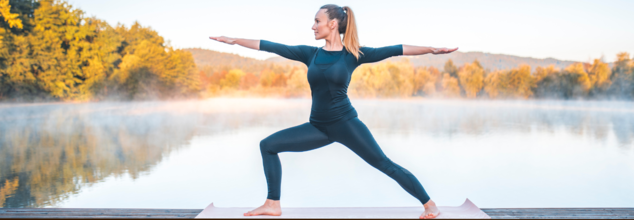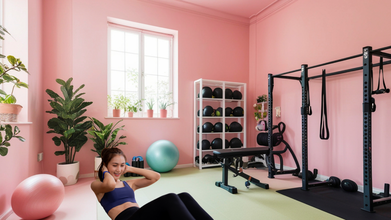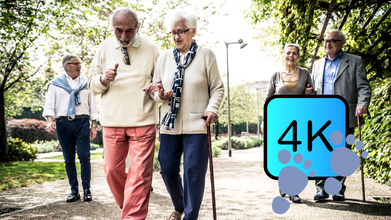- Health Conditions A-Z
- Health & Wellness
- Nutrition
- Fitness
- Health News
- Ayurveda
- Videos
- Medicine A-Z
- Parenting
- Web Stories
Yoga Poses For Beginners: 5 Effective Asanas To Lose Weight

Beginners Yoga (Credit: Canva)
Yoga is more than just a path to relaxation and mental clarity; it's a powerful tool for physical transformation as well. If you're looking to shed extra pounds and improve your overall fitness, yoga can help you build strength, flexibility, and balance while burning calories. The best part? You don’t need to be an expert to start!
These beginner-friendly yoga asanas are simple but effective in promoting weight loss. Incorporating them into your daily routine, along with proper diet and hydration, will set you on the path to a healthier, fitter version of yourself. So, grab your mat, get started, and enjoy the benefits of yoga for both body and mind!
Here are five beginner-friendly yoga asanas (poses) that will kickstart your weight loss journey.
1. Surya Namaskar (Sun Salutation)
Surya Namaskar is the perfect warm-up for any yoga practice and a complete workout in itself. It consists of a sequence of 12 powerful poses that stretch and strengthen all parts of your body. Performing several rounds of Sun Salutation can increase your heart rate, improve circulation, and burn calories.
How to perform:
- Stand at the front of your mat with your feet together.
- Inhale, stretch your arms overhead, and exhale as you fold forward.
- Jump or step your feet back into a plank position.
- Lower your body to the mat (Chaturanga), then lift your chest into Cobra pose.
- Exhale and push back into Downward-Facing Dog.
- Step or jump your feet back to your hands and come up to a standing position.
Repeat this flow 8-10 times to build strength and endurance.
2. Naukasana (Boat Pose)
Boat Pose is great for strengthening your core, toning your abdominal muscles, and promoting weight loss. It engages your entire body, especially the lower abdomen and hip flexors, which are key areas when it comes to losing weight.
How to perform:
- Sit on the mat with your legs stretched out in front of you.
- Lift your legs off the floor while keeping them straight.
- Simultaneously, lean your upper body back slightly, forming a “V” shape with your torso and legs.
- Keep your arms parallel to the ground and hold the position for 20-30 seconds.
Repeat this 3-4 times, focusing on your core engagement.
3. Virabhadrasana II (Warrior II Pose)
Warrior II is an excellent pose to strengthen your legs, shoulders, and back while improving balance. It can help tone your lower body and burn fat when practiced with focus and proper alignment.
How to perform:
- Stand with your legs 3-4 feet apart.
- Turn your right foot out 90 degrees and your left foot in slightly.
- Bend your right knee to a 90-degree angle while keeping your left leg straight.
- Raise your arms parallel to the ground, reaching out in both directions.
- Hold for 30-60 seconds, then switch sides.
This pose, when held for longer periods, can build endurance and help burn calories.
4. Setu Bandhasana (Bridge Pose)
Bridge Pose is a fantastic way to tone your glutes, thighs, and core. It helps stretch the spine and promotes fat loss, especially in the abdominal area.
How to perform:
- Lie on your back with your knees bent and feet flat on the floor.
- Press your feet into the ground as you lift your hips toward the ceiling.
- Clasp your hands under your back and hold for 30 seconds.
- Lower your hips slowly back to the ground.
Repeat this 4-5 times to strengthen your core and glutes.
5. Utkatasana (Chair Pose)
Chair Pose targets the thighs, glutes, and core, making it perfect for weight loss. Holding this pose will elevate your heart rate and strengthen the lower body.
How to perform:
- Stand with your feet together and arms by your side.
- Inhale, raise your arms above your head, and exhale as you bend your knees as if you’re sitting in a chair.
- Keep your weight in your heels and hold the pose for 30 seconds to 1 minute.
Did President Trump Have A Stroke? His Walk Suggests So, Says A 'Physical Therapist' As He Explains How Someone's Gait Can Reveal A Lot

Credits: AFP and Instagram
"He walks like this because he's had a stroke and his spatial awareness, balance, strength and gait have all been affected," says a person who claims to be a 'Physical Therapist at a home healthcare, and claims to have a doctorate in his field with 14 years of experience. The video is posted on his Instagram channel @epistemiccrisis with 74.2k followers.
What Are His Claim About President Trump's Stroke?
He claims that the reason why President Trump is Did President Trump Have A Stroke? This 'Physical Therapist' Explains Why He Believes Soall across the red carpet in a video that plays in the background is because "he lacks the spatial awareness to stay on target or on the path in a straight line".
He further says, "This is because I believe he's had a stroke that's affected the left side of his brain and caused weakness on the right side of his body. When one side of your body is weaker than the other, it can become difficult to walk in a straight line anyone. But aside from the physical weakness, your balance is affected as well."
In fact, a 2021 study published in journal Healthcare notes that stroke is a major cause of disability worldwide and balance impairments are common disabling factors in patients with stroke, which could lead to falls.
However, as per the official medical records of the president, no such strokes were mentioned. His medical report pronounced him in "excellent health". The examination was done at Walter Reed National Military Medical Center. The report also emphasized that Trump maintains a "demanding daily schedule without restriction". Not only that, the report has gone so far to declare Trump's cardiac age as 14 years younger than his actual age after an electrocardiogram.
Read More: What Does Trump's Latest Health Checkup Reveal About Him?
Though the 'Physical Therapist' believes otherwise. He says that when he went back to Walter Reed for his checkup, it was a six-week follow-up for a stroke event that "he probably had over Labor Day". "A stroke on the left side of the brain would also explain why he talks nonsense so much more often nowadays and also why when he is fatigued after long travel like you see in that video, his speech is much slower, much quieter and much more slurred," he claims.
The 'Physical Therapist' further claims that being 80-years old, Trump is also experiencing age-related cognitive decline.
Read: Why Is This Doctor Asking President Trump To Take Alzheimer's Test?
Have Their Been Other Claims On President Trump's Health?
Previously, Dr Narinder Kapur, a consultant neuropsychologist and visiting professor at the University College London said that president's behavior over the last six months has been "quite odd and strange," as reported by Express, UK. He said that there may be a possibility of frontotemporal dementia, that the President must take a test for.
There were also claims about President's 'riddled with arthritis' condition and the need for a double hip replacement surgery. Furthermore, Kai Trump, president's granddaughter's latest Instagram post have also raised questions abut his health, especially the hand bruise.
This is not the first time the 'Physical Therapist' from the account @epsitemiccrisis has made a claim about president Trump. In the past, he linked president's use of smaller stairs to climb to the aircraft with having a stroke. He said that he is using smaller sets of stair so "the public won't notice that he's had a stroke". He explains that when someone's had a stroke, it can involve paralysis of the perineal nerve. This bends your foot up towards your head during your walking. If this nerve is paralyzed, you get a "foot drop". He also claimed that the same thing happened with Joe Biden as he also changed with smaller sets of stairs.
However, none of his claims have been attributed, and the White House does medical reports do not corroborated any of such news.
Note: This piece is based on the claims made by the account @epistemiccrisis. Health And Me does not authenticate any of these claims.
What Home Gym Tools Can Help You Stay Fit Without Hitting The Gym?

Credits: Canva
We all know working out had great benefits, but do you also sometimes feel too lazy to go to the gym? Well, you can now work out at your home. For many, the idea of hitting the gym, or waiting for your turn to use the machine, or just dealing with crowd in general could derail the motivation. But, the good news is that there are tools you can buy and set your own home gym.
Bollywood actor Kareena Kapoor Khan's fitness trainer Mahesh Ghanekar also swears by such high-impact equipment. We have shortlisted 8 must have home gym tools from his list that you must have!
Dumbbells
This is a classic one, but is of course a classic strength builder. If there’s one piece of equipment that should top your list, it’s a good pair of dumbbells. Ghanekar recommends a range from 2.5 kg to 20 kg, depending on your level.
Dumbbells help target every major muscle group, from shoulders to glutes, and can be used for both toning and compound movements like squats and presses. Studies also show that free-weight exercises with dumbbells improve muscle coordination and strength more effectively than machines.
Kettlebell
Another classic, and it helps with both strength and endurance. It is compact, but the impact is powerful. They are a great equipment for dynamic movements like swings, snatches, and squats. Ghanekar suggests that you can start with a 5 to 12 kg kettlebell for home use.
Resistance Bands
While they seem easy, they are the best equipment for portable gym. They are most versatile and space-saving workout tools. You can use them for strength training, stretching, or even rehabilitation.
According to Ghanekar, they’re perfect for beginners and advanced exercisers alike because they engage stabilizing muscles and improve flexibility, all without putting too much strain on joints.
Jump Rope
The best way to do cardio at home is by jumping rope. A jump rope is one of the best cardio tools you can own. It enhances coordination, burns calories fast, and boosts cardiovascular health.
Just ten minutes of skipping can match the benefits of a 30-minute jog, says Ghanekar. It’s small, portable, and easy to store, making it an ideal home essential.
Adjustable Bench
An adjustable bench allows you to perform a variety of exercises like presses, step-ups, or core work.
Ghanekar says that the incline and decline positions help activate different muscle areas, especially the chest and arms, allowing a more rounded strength routine at home.
Yoga Mat
A yoga mat is more than just for yoga. It’s a must-have for stretching, pilates, or even bodyweight exercises.
Ghanekar recommends investing in a thick, non-slip mat to improve posture, prevent injuries, and create a dedicated space for mindfulness and recovery.
Foam Roller
Post-workout recovery is as important as training. A foam roller helps release tight muscles, improve circulation, and prevent soreness.
Ghanekar says regular foam rolling can enhance flexibility and speed up recovery, allowing you to stay consistent with your workouts.
Stepper
A simple stepper or aerobic platform is a great way to tone your legs, improve balance, and get your heart pumping.
Ghanekar highlights that stepping workouts improve lower-body endurance and cardiovascular fitness, and can even reduce body fat when done consistently.
Seniors, Pay Attention! Walking Just 4,000 Steps Once a Week Can Significantly Lower Your Risk of Early Death

Credits: Canva
Walking has a lot of benefits, we already know that. However, how much should one walk? a recent study among older people revealed that if seniors could achieve a 4,000 steps goal in one to two days in a week, they would lower their risk of early deaths by a quarter.
This study was led by Harvard University, and published in the British Journal of Sports Medicine.
What Did the Study Find About Older People's Health And Walking?
We all know that staying active brings great health benefits. In fact, Health and Me also covered how walking and staying active could lower the risk of dementia. Until now, however, it was unclear how much should one walk.
With this recent study, researchers found that achieving 4,000 steps per day on one or two days a week could lower risk of death and lower risk of cardiovascular disease, (CVD), as compared to not reaching this level on any day.
How Was The Study That Analyzed Older People's Walking And Its Impact On Health Conducted?
The study analyzed 13,547 American women, who were over the age of 62, with the average being 72. All of them were given trackers for seven consecutive days, between 2011 and 2015. These people were followed for over a decade. None of them had heart disease or cancer at the beginning of the study.
While they were being monitored in the end of 2024, 1,756 women died and 781 developed heart disease.
The study found that those who clocked up at least 4,000 steps a day on one or two days of the week had 26% lower risk of death from all causes, and a 27% lower risk of dying from heart diseases. This was as compared to those who did not reach this threshold on any day of the week. The study further saw that those who achieved the step count for three days of the week, their lower risk of death from any cause increased by 40%, however for CVD related deaths, it remained at 27%.
Takeaways And Limitations
The researchers said that while the most important take away was that people would now have an amount to walk. However, it is important to note that the study was observational, with no firm conclusion, and was done only on women, and assessed for only one week.
The researchers agreed that there is no "best" way to take your steps. The key is to just ensure that you are getting your steps in. "A greater number of steps, regardless of daily patterns, is associated with better health outcomes." The study saw that on an average, women took 5,615 steps a day.
While there were limitations, but the researchers still added, "An important translational implication of these findings is that since step volume is the important driver of the inverse associations, there is no ‘better’ or ‘best’ pattern to take steps; individuals can undertake [physical activity] in any preferred pattern (eg ‘slow and steady’ v ‘bunched patterns’) for lower mortality and CVD risk, at least among older women. These findings provide additional evidence for considering including step metrics in the next [physical activity] guidelines, and that ‘bunching’ steps is a viable option for health.”
© 2024 Bennett, Coleman & Company Limited

